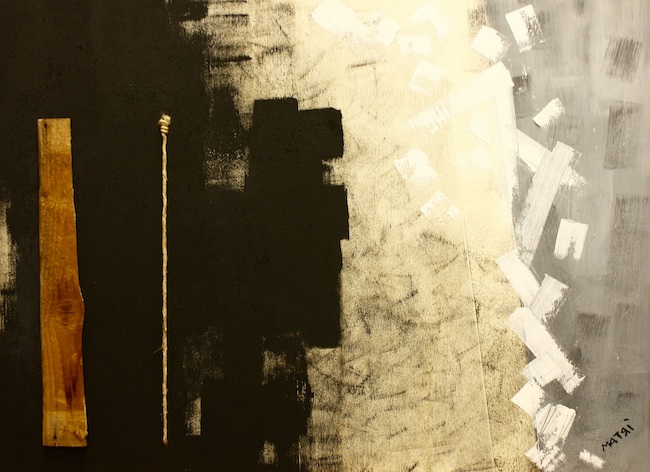Il raggiungimento di una forma espressiva astratta costituisce a volte l’evoluzione di un percorso differente in cui la narrazione della realtà così come osservata comincia a costituire un limite al libero sentire dell’artista; in questo specifico caso la trasformazione dello stile pittorico è profondo e intenso proprio perché incentivato da quel bisogno di avvicinarsi senza regole alla manifestazione rappresentativa più affine alla reale essenza dell’esecutore dell’opera. Il protagonista di oggi ha compiuto questo tipo di percorso che lo ha condotto verso un linguaggio personale dove la concretezza della materia si unisce all’emozionalità del sentire.
Il passaggio verso la scomposizione dell’immagine cominciò a delinearsi intorno alla fine del Diciannovesimo secolo, quando cioè i grandi artisti appartenenti all’Impressionismo frammentarono la realtà osservata attraverso una tecnica costituita da rapide e brevi pennellate, prive di disegno iniziale, per accordarsi sia alla velocità esecutiva volta a impedire loro di perdere quell’attimo osservato open air in virtù del quale immortalavano la luce, i riflessi e l’atmosfera del luogo riprodotto, sia alla ricerca di un equilibrio estetico tendente alla perfezione figurativa dell’osservato. Il risultato fu un singolare effetto mai visto in precedenza, quello di scoprire l’immagine allontanandosi dalla tela e perdendone, al contrario, i dettagli avvicinandosi; la fase impressionista fu il principio di una ricerca evolutiva che contribuì a generare le varie correnti pittoriche che intendevano distaccarsi dai canoni classici e tradizionali dell’arte per entrare nelle innovazioni e nelle avanguardie del Ventesimo secolo. Il Divisionismo di cui Giovanni Segantini fu uno dei massimi esponenti, proseguì la ricerca di scomposizione suddividendo le immagini in sottili linee in cui l’associazione di tonalità differenti riusciva a riprodurre perfettamente l’effetto luminoso e limpido della luce, tanto quanto a mettere in evidenza le varie sfumature di un paesaggio; poco dopo lo stesso Futurismo scelse di accogliere e ampliare il concetto della frammentazione del reale in tratti, via via più geometrizzati, per infondere nell’osservatore il senso di movimento e di velocità costituente la linea guida della corrente pittorica ed evidente nelle opere coinvolgenti e senza tempo di Filippo Tommaso Marinetti. A seguire il Cubismo, fondato da Pablo Picasso e Georges Braque, si impose di scoprire e mostrare punti di vista contemporanei sulle diverse angolazioni dei soggetti e della realtà e poi, lentamente e sulla base del proseguire nella ricerca del concetto accolta da altri artisti coevi, la scomposizione ebbe la sua massima attuazione nell’Astrattismo, nel Neoplasticismo, nel Suprematismo e, in seguito nell’Espressionismo Astratto e nell’Informale Materico in cui la solidità di oggetti di uso comune, spesso materiali poveri, interagivano con la tela rendendo più concreto e consistente il percorso di presa di coscienza emozionale legato all’interiorità del singolo artista, passando dalle plastiche bruciate e le tele di juta da cui emergeva la sofferenza degli orrori del secondo conflitto mondiale di Alberto Burri alla sensibilità spiritualista di Antoni Tapìes le cui opere si avvicinano anche all’Arte Povera. L’artista altoatesino Mauro Trincanato, in arte MATяÌ, percorre nella sua carriera artistica alcune delle tappe che si sono susseguite nei decenni di passaggio tra fine Ottocento e inizi Novecento, trasformandole in ricerca personale tendente verso una realizzazione creativa quasi inconsapevole, come se i precedenti stili con cui si è cimentato fossero una guida verso un ritrovamento del sé pittorico in grado di farlo giungere al linguaggio che nel momento attuale lo definisce.
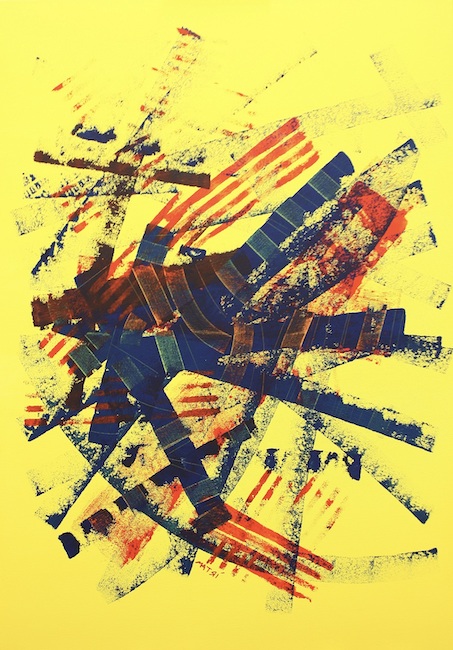
A partire dagli anni Settanta del secolo scorso infatti, ha sperimentato la figurazione del paesaggio, della riproduzione di ambienti silenziosi in cui la natura costituiva l’unica voce espressiva; poi lentamente è emersa la necessità di spostarsi verso una scomposizione sempre maggiore dell’immagine per permettere al suo io interiore di manifestarsi sottolineando la rilevanza della sostanza sulla forma, sebbene già in precedenza decisamente orientato all’ascolto emozionale, determinando dunque il passaggio verso l’Espressionismo Astratto prima e nell’Informale Materico poi.
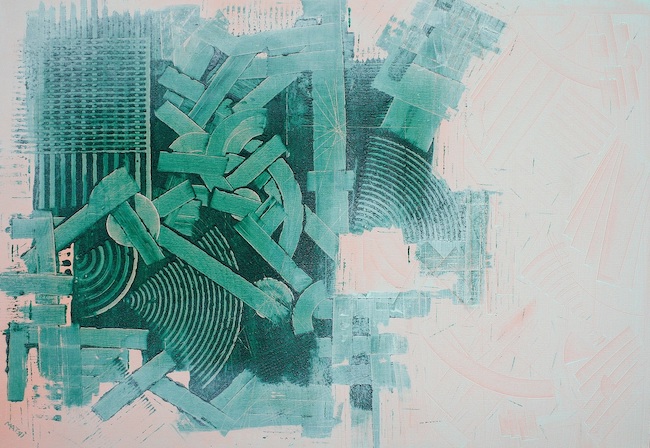
Tutto ciò verso cui tende Mauro Trincanato è quel bilanciamento, quell’unione tra l’immediatezza del sentire e la necessità di poterlo in qualche modo interiorizzare e rendere concreto attraverso lo studio della materia con la quale completa l’opera stessa, quell’agire è un prendere atto dell’intensità dell’emozione e ripercorrerla anche grazie all’interazione con l’ambiente circostante, alla ricerca di una terza dimensione funzionale a dare rilievo e tangibilità alle sensazioni percepite.
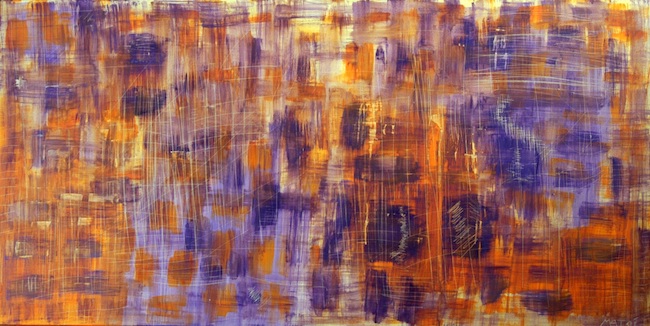
Le opere più legate all’Espressionismo Astratto, come Sinfonia d’Autunno, lasciano emergere la capacità di Trincanato di porsi in posizione di ascolto lasciando che i naturali colori che l’ambiente gli comunica fuoriescano liberi, senza condizionamenti razionali su cosa sarebbe più affine alla realtà bensì concedendo al suo sentire di trasformare le tonalità reali in quelle maggiormente in accordo con ciò che l’osservato significa per lui, che suscita nelle sue profondità interiori; ecco dunque che il giallo aranciato delle foglie viene associato al lilla della sottile malinconia che avvolge la stagione in cui la natura si ferma in attesa di un nuovo risveglio e che non può non suscitare un senso di nostalgia verso i ricordi dell’estate appena terminata.
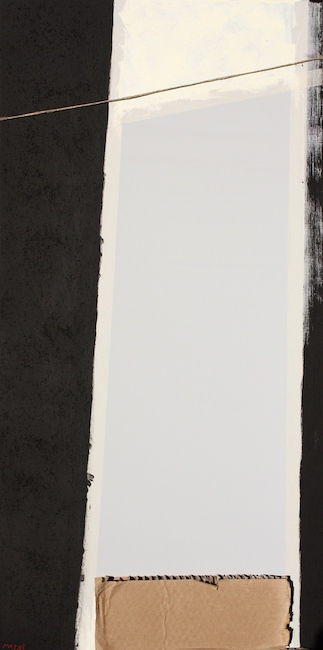
Il passaggio all’Informale Materico determina invece una revisione della gamma cromatica tendente sempre di più verso i colori primari, con qualche eccezione, quelle tonalità basiche, essenziali, che raccontano tutto semplicemente declinandole in maniera più sfumata o frastagliata oppure associandole l’una all’altra con differente consecutività; il messaggio espressivo è in ogni caso potente, forte, soprattutto quando Mauro Trincanato esplora le sensazioni insite nell’essere umano, quel desiderare di scoprire i misteri del proprio stesso animo per ricevere risposte ai propri dubbi, al proprio bisogno di andare oltre il determinato o il prestabilito e cercare un significato differente.
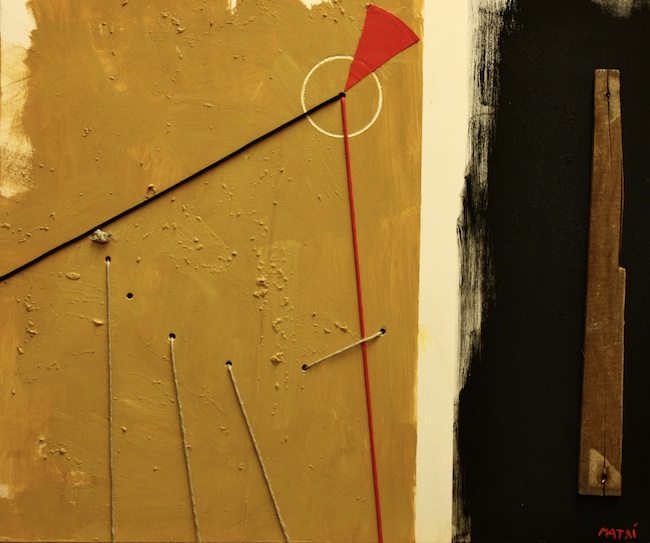
Nell’opera Spaziotempo la base cromatica composta di colori terrosi come l’ocra, e primari come il bianco e il nero, sembra evidenziare il passaggio tra due dimensioni separate eppure in continua interazione, in consequenzialità che diviene la base di ciascuna esperienza, spesso di stampo destinico senza cui non vi sarebbe la necessaria presa di coscienza di sé e la relativa evoluzione. La materia determina da un lato le linee del tempo, simili perciò alle lancette dell’orologio che è lo strumento attraverso cui se ne scandisce il passare, rappresentate da sottili fili di corda, dall’altro invece la consistenza dello spazio, narrata attraverso un frammento di legno a sottolineare quanto in fondo tutto sia comunque delimitato e abbia una sua finitezza.
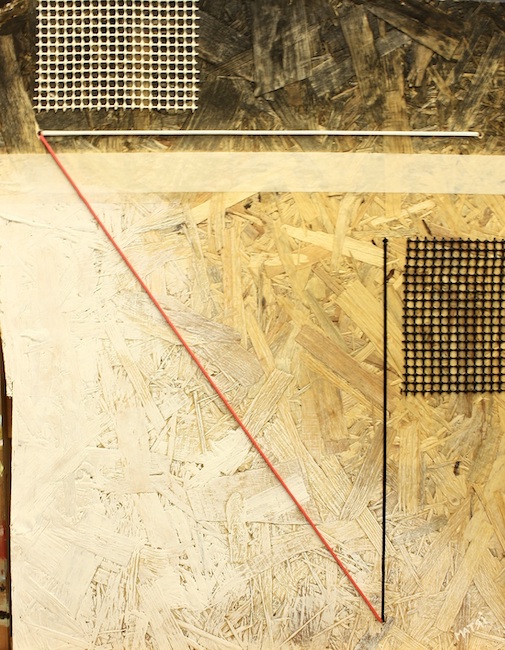
Medesima alternanza emerge nell’opera La congiunzione degli opposti in cui Trincanato mette in evidenza quanto spesso si tenda a prendere distanza o direzione differente da qualcuno, o da qualcosa, solo perché sembra essere lontana dal proprio modo di sentire e di vedere la realtà, mentre in realtà basterebbe la capacità di andare oltre la superficie per scoprire quanto altro potrebbe invece unire quell’apparente dissonanza; in questo caso le tonalità scelte sono più chiare, sfumate, frastagliate, come a indicare le difficoltà e le stratificazioni di esperienze attraverso cui costruire le certezze, le peculiarità caratteriali a seguito delle quali, pur arroccandosi spesso nelle proprie posizioni, possono indurre l’individuo ad aprirsi alla possibilità di conciliarsi con il lontano opposto, costituito da due stralci distanti di rete e idealmente uniti da un filo di corda evocante il cammino necessario per colmarla quella distanza.
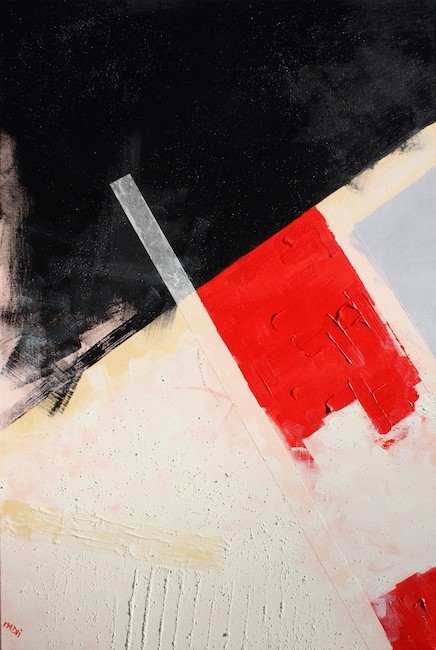
Artista da sempre, malgrado una scelta professionale che lo ha condotto verso un approccio decisamente più contenuto e riservato rispetto alla libertà espressiva che raggiunge attraverso la manifestazione creativa, Mauro Trincanato ha all’attivo molte mostre personali e collettive in Italia e all’estero.
MAURO TRINCANATO-CONTATTI
Email: mauro.trincanato@gmail.com
Sito web: www.artemati.com
The concrete emotional path in Mauro Trincanato’s Material Informalism
The achievement of an abstract expressive form sometimes constitutes the evolution of a different path in which the narration of reality as observed begins to constitute a limit to the artist’s free feeling; in this specific case the transformation of the pictorial style is profound and intense precisely because it is stimulated by the need to approach without rules the representative manifestation more akin to the real essence of the work’s executor. Today’s protagonist has followed this type of path, which has led him towards a personal language where the concreteness of the material combines with the emotionality of feeling.
The transition towards the decomposition of the image began to take shape around the end of the nineteenth century, when the great artists of Impressionism fragmented the reality they observed through a technique consisting of rapid, short brushstrokes, with no initial design, in order to comply both with the speed of execution aimed at preventing them from losing that moment observed in the open air by virtue of which they immortalised the light, reflections and atmosphere of the place reproduced, and with the search for an aesthetic balance tending towards the figurative perfection of the observed. The result was a singular effect never seen before, that of discovering the image by moving away from the canvas and losing its details by going closer. The Impressionist phase was the beginning of an evolutionary research that contributed to generate the various pictorial currents that intended to break away from the classical and traditional canons of art and enter into the innovations and avant-gardes of the 20th century. Divisionism, of which Giovanni Segantini was one of the greatest exponents, continued the search for decomposition by subdividing images into thin lines in which the association of different shades succeeded in perfectly reproducing the luminous and limpid effect of light, as well as highlighting the various nuances of a landscape; shortly afterwards, Futurism itself chose to embrace and expand the concept of fragmenting reality into increasingly geometric strokes in order to instil in the viewer the sense of movement and speed that was the guiding principle of the pictorial current and was evident in the engaging and timeless artworks of Filippo Tommaso Marinetti.
Following, Cubism, founded by Pablo Picasso and Georges Braque, set out to discover and show contemporary points of view on the different angles of subjects and reality and then, slowly and on the basis of the continuing research into the concept taken up by other contemporary artists, decomposition had its fullest implementation in Abstractionism, Neoplasticism, Suprematism and, later, in Abstract Expressionism and Material Informalism in which the solidity of everyday objects, often poor materials, interacted with the canvas, making the path of emotional awareness linked to the interiority of the individual artist more concrete and consistent, moving from the burnt plastics and jute canvases by Alberto Burri, from which emerged the suffering of the horrors of the Second World War to the spiritualist sensitivity of Antoni Tapìes, whose artworks also come close to Arte Povera. The South Tyrolean artist Mauro Trincanato, known as MATяÌ, covers in his artistic career some of the stages that took place in the decades between the end of the nineteenth century and the beginning of the twentieth century, transforming them into a personal quest tending towards an almost unconscious creative realisation, as if the previous styles with which he grappled were a guide towards a rediscovery of the pictorial self capable of leading him to the language that defines him today. In fact, from the 1970s onwards, he experimented with landscape figuration, with the reproduction of silent environments in which nature constituted the only expressive voice.
Then, slowly, the need to move towards an ever greater decomposition of the image emerged in order to allow his inner self to manifest itself, emphasising the importance of substance over form, although he had already previously been decidedly oriented towards emotional listening, thus determining the transition first towards Abstract Expressionism and then towards Material Informalism. All that Mauro Trincanato tends towards is that balance, that union between the immediacy of feeling and the need to be able in some way to internalise it and make it concrete through the study of the material with which he completes the artwork itself, that acting is a taking note of the intensity of the emotion and retracing it also thanks to the interaction with the surrounding environment, in search of a third dimension functional to give relief and tangibility to the sensations perceived. The artworks more closely linked to Abstract Expressionism, such as Sinfonia d’Autunno (Autumn Symphony), reveal Trincanato’s ability to place himself in a position of listening, letting the natural colours that the environment communicates to him come out freely, without rational conditioning as to what would be more akin to reality, but allowing his feelings to transform the real tones into those that are more in tune with what the observed means to him, that it arouses in his inner depths; thus, the orangey yellow of the leaves is associated with the lilac of the subtle melancholy that envelops the season in which nature stops waiting for a new awakening and that cannot but arouse a sense of nostalgia for the memories of the summer that has just ended. The transition to Material Informalism, on the other hand, leads to a revision of the chromatic range, which tends increasingly towards primary colours, with a few exceptions, those basic, essential shades that tell the whole story simply by declining them in a more nuanced or jagged manner, or by associating them with each other with different consecutiveness; the expressive message is in any case powerful, strong, especially when Mauro Trincanato explores the sensations inherent in the human being, that desire to discover the mysteries of one’s own soul in order to receive answers to one’s doubts, to one’s need to go beyond the definite or the pre-established and seek a different meaning.
In the work Spaziotempo (Spacetime), the chromatic base composed of earthy colours such as ochre, and primary colours such as black and white, seems to highlight the passage between two separate dimensions that are nevertheless in continuous interaction, in a consequentiality that becomes the basis of each experience, often destiny-like, without which there would not be the necessary self-awareness and evolution. The material determines, on the one hand, the lines of time, similar therefore to the hands of the clock, which is the instrument through which the passage of time is marked, represented by thin strings of rope, while on the other hand it determines the consistency of space, narrated through a fragment of wood to underline how everything is in any case delimited and has its own finiteness. The same alternation emerges in the artwork La congiunzione degli opposti (The conjunction of opposites), in which Trincanato highlights how often we tend to take a different distance or direction from someone, or something, just because it seems to be far from our way of feeling and seeing reality, when in reality it would be enough to go beyond the surface to discover how much more could unite that apparent dissonance; in this case the shades chosen are lighter, shaded, jagged, as if to indicate the difficulties and stratifications of experience through which to build the certainties, the character peculiarities as a result of which, while often entrenched in their positions, can lead the individual to open up to the possibility of reconciling with the far opposite, made up of two distant pieces of grid and ideally united by a thread of rope evoking the path necessary to bridge that distance. Lifelong artist, despite a professional choice that has led him towards a decidedly more restrained and reserved approach than the one of the expressive freedom he achieves through creative expression, Mauro Trincanato has to his credit many personal and collective exhibitions in Italy and abroad.


